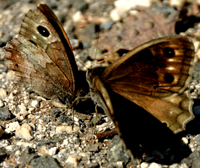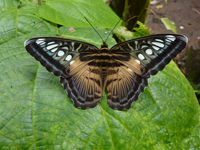Systematics, biogeography, molecular phylogeny, ethology and conservation of Butterflies
Our laboratory is currently involved in several basic studies on butterflies that can be applied to the field of Conservation Biology
Spatial and temporal patterns of genetic variation, phylogeography and ecological niche modelling approachPeople
V.Sbordoni, D.Cesaroni, G.Allegrucci, P.Gratton, S.Marta, G.Riccarducci, A.Trasatti, V.Todisco
Analyses of the genetic population structure at different geographic scales and by different molecular tools has been addressed to improve empirical estimation of evolutionary parameters and processes for several butterfly species. Populations of mountain species, displaying similar geographic distributions, but different ecological requirements, have offered a unique opportunity for investigating the influence of past climate changes in assembling the diversity of European biotas. Phylogeographic comparative analysis and Bayesian coalescent approaches are applied to obtain a detailed depiction of the history of European populations through the Pleistocene. The Bayesian inference used to clarify past demographic trends of species is compared to ecological niche modelling analysis in order to theorize present, past and future potential distribution of species.
Phylogeny, biogeography and DNAbarcode of Sino-Himalayan butterfliesPeople
V.Sbordoni, D.Cesaroni, G.Allegrucci, T.Deodati, V.Todisco
Research on taxonomy, molecular phylogeny, zoogeography and mtDNA (COI) sequences for DNA Barcode are currently in progress for several butterfly taxa showing Sino-Himalayan distribution patterns. We are particularly interested in the times and modes of the cladogenetic events leading to the evolution of several Sino-Himalayan speciose butterfly genera. Stepwise speciation events revealed over time are analysed in relation to the complex topography of this region, with steep mountains alternated to deep valleys resulting in a wide range of local climatic conditions, whereas tectonic and other historical processes could have driven older cladogenetic processes.
Taxonomic and faunistic studies of butterflies and mothsPeople
V.Sbordoni, D.Cesaroni, M.Lucarelli, M.Di Rao, G.Pandolfi, M.Pinzari
Besides a collection of birds from Italy, our laboratory houses remarkable collections of butterflies from around the world and Italian moths, that represent the basis to perform taxonomic and morphological studies (including genitalic structures) as well as faunistic researches at regional level carried out on behalf of the Observatory for Biodiversity of Latium (OBL) by means of biodiversity databases and GIS.
Ethology and mating behaviourPeople
V.Sbordoni, M.Di Rao, M.Pinzari
The evolutionary history of courtship behaviour allows to characterize the mating signals involved in species recognition. Experiments have been performed to describe and compare courtship behaviour among Hipparchia species and to show the degree of change in courtship sequence with respect to species relatedness. The study of some aspects of reproductive behaviour of Euphydryas aurinia are also in progress. In collaboration with M.Santonico, G.Pennazza, A.D'Amico, C.Di Natale (Engineering) and R.Paolesse (Chemistry), the species-specific chemical stimuli involved in courtship in two cryptic Hipparchia species have been studied by using an “Electronic Nose”, developed at the Dept. of Electronic Engineering and the Dept. of Chemistry (Tor Vergata University).
Population genetics and molecular phylogeny
Todisco, V., Gratton, P., Zakharov, E. V., Wheat, C. W., Sbordoni, V. and Sperling, F. A.H. 2012. Mitochondrial phylogeography of the Holarctic Parnassius phoebus complex supports a recent refugial model for alpine butterflies. Journal of Biogeography, 39: 1058–1072.
Riccarducci, G. 2011. Tracciando la storia evolutiva di Melanargia arge e Maniola jurtina (Lepidoptera, Nymphalidae) attraverso il DNA barcode. Tesi di Dottorato di Ricerca in Biologia Evoluzionistica ed Ecologia. Università di Roma "Tor Vergata"
Todisco, V., Gratton, P., Cesaroni, D., & Sbordoni, V. 2010. Phylogeography of Parnassius apollo: hints on taxonomy and conservation of a vulnerable glacial butterfly invader. Biological Journal of the Linnean Society, 101(1), 169-183.
Sbordoni V., 2010. Strength and Limitations of DNA Barcode under the Multidimensional Species Perspective. Nimis P. L., Vignes Lebbe R. (eds.) Tools for Identifying Biodiversity: Progress and Problems – pp. 271–276. ISBN 978-88-8303-295-0.
Deodati, T., Cesaroni, D., & Sbordoni, V. 2009. Molecular phylogeny, classification, and biogeographic origin of Callerebia and other related Sino-Himalayan genera (Insecta: Lepidoptera: Nymphalidae: Satyrinae). In Hartmann M. and J.Weipert (a cura di), Biodiversität und Naturausstattung im Himalaya III (Biodiversity and natural heritage of the Himalaya III) (pp. 107-114). Verein der Freunde und Förderer des Naturkundemuseums Erfurt e.V., Erfurt, Germany.
Sbordoni V. 2009. Il problema della specie in biologia: da Darwin e Wallace al DNA barcode. Rendiconti - Accademia Nazionale Delle Scienze Detta Dei Xl. Memorie Di Scienze Fisiche E Naturali, vol. serie V, 32; p. 7-26, ISSN: 0392-4130.
Gratton, P., & Sbordoni, V. 2009. Isolation of novel microsatellite markers for the clouded Apollo (P-mnemosyne Linnaeus, 1758; Lepidoptera, Papilionidae). Conservation Genetics, 10(4), 1141-1143.
Gratton P., Konopiński M., and V. Sbordoni. 2008. Pleistocene evolutionary history of Parnassius mnemosyne in Central and Eastern Europe: genetic and demographic consequences of climate cycles and support to the “time dependency” of mutation rates. Molecular Ecology: 17, 4248–4262.
Gratton P., Sbordoni V. 2008. Isolation of novel microsatellite markers for the Clouded Apollo (Parnassius mnemosyne Linnaeus, 1758; Lepidoptera, Papilionidae). Conservation Genetics. 10: 1141-1143.
Gratton P., V. Todisco e V. Sbordoni. 2006. Filogeografia comparata di Parnassius apollo e P. mnemosyne. Un contributo genetico-molecolare alla biogeografia dell’Appennino. Biogeographia 27:189-201.
Gratton, P. & V.Sbordoni. 2005. Conservation genetics and phylogeography of Parnassius mnemosyne. pp. 41-44. In: E.Kühn, R.Feldmann, J.A.Thomas & J.Settele (Eds.), "Studies on the Ecology and Conservation of Butterflies in Europe. Vol. 1: General Concepts and Case Studies". Pensoft Series Faunistica No 52 (ISSN 1312-0174). Pensoft Publishers, Sofia.
Taxonomy and faunistic studies
M.Pinzari, M.Pinzari and A.Zilli. 2010. Deep lepidopterological exploration of Mt Cagno and surroundings (Central Italy), a restricted mountain Massif and hotspot for butterfly and moth diversity. Bollettino dell’Associazione Romana di Entomologia, 65 (1-4): 3-383.
M.Pinzari, M.Pinzari e A.Zilli. 2006. Nuovi dati sui Tortricidi italiani (Lepidoptera, Tortricidae). Bollettino dell'Associazione Romana di Entomologia, 61(1-4): 53-101.
Della Bruna, C., Gallo, E., and Sbordoni, V. 2004. Pieridae part I, Subfamily Pierinae, Tribe Pieriini(partim): Delias,Aporia,Mesapia, Baltia, Pontia,Belenois,Talbotia. Milano : Omnes Artes.
Della Bruna, C.; E. Gallo, M. Lucarelli & V. Sbordoni. 2002. Guide to the butterfly of the Paleartic region. Satyrinae part II. - Second Edition - Ed. c.Bozano, Omnes Artes, Milano.
Ethology
M.Pinzari and V.Sbordoni, 2013. Species and mate recognition in two sympatric Grayling butterflies: Hipparchia fagi and H. hermione genava (Lepidoptera). Ethology, Ecology and Evolution. 25(1): 28-51.
M. Pinzari. 2009. A Comparative Analysis of Mating Recognition Signals in Graylings: Hipparchia statilinus vs. H. semele (Lepidoptera: Nymphalidae, Satyrinae) Journal of Insect Behavior, 22: 227–244.
 Hipparchia statilinus
Hipparchia statilinus Parthenos sylvia salentia
Parthenos sylvia salentia